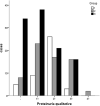Clinical and pathological characteristics of ANA/anti-dsDNA positive patients with antineutrophil cytoplasmic autoantibody-associated vasculitis
- PMID: 32964277
- PMCID: PMC7835286
- DOI: 10.1007/s00296-020-04704-3
Clinical and pathological characteristics of ANA/anti-dsDNA positive patients with antineutrophil cytoplasmic autoantibody-associated vasculitis
Abstract
Antineutrophil cytoplasmic autoantibodies (ANCA) associated vasculitis (AAV) consists of a group of systemic autoimmune diseases. The roles of serum anti-nuclear antibodies (ANA) and anti-double-stranded DNA (anti-dsDNA) antibodies in AAV patients remain unknown. This study investigated the prevalence of serum ANAs and anti-dsDNA antibodies in AAV patients and characterized the clinical and pathological features of these patients. A total of 218 AAV patients were enrolled. Clinical and pathological data of patients were analyzed retrospectively. Of the 218 AAV patients, 109 (50.0%) were positive for ANA, 45 (20.6%) were positive for anti-dsDNA, and 43 (19.7%) were positive for both. The AAV patients with ANA had severer kidney damage and more chronic renal histopathological changes compared to those who were negative for ANA. Specifically, patients positive for ANA had more hypertension, higher levels of urea nitrogen and serum creatinine, lower estimated glomerular filtration rate (eGFR), more end-stage renal disease (ESRD), severer proteinuria, glomerular sclerosis, tubular interstitial fibrosis and tubular atrophy, and were more likely to receive renal biopsies compared to ANA negative patients. The study found ANA and anti-dsDNA in AVV patients were not rare, ANA-positive AAV patients had severer kidney damage and more chronic renal histopathological changes compared to ANA-negative AAV patients. Renal biopsy is strongly recommended for differential diagnosis in such cases.
Keywords: Anti-double stranded DNA antibodies (anti-dsDNA); Anti-nuclear antibody (ANA); Antineutrophil cytoplasmic autoantibodies (ANCA); Associated vasculitis (AAV); Clinicopathological characteristics.
Conflict of interest statement
The authors declare that they have no competing interests.
Figures
Similar articles
-
Clinicopathological Features and Outcomes of IgA Nephropathy with Serum Antineutrophil Cytoplasmic Autoantibody Positivity.Am J Nephrol. 2023;54(9-10):416-424. doi: 10.1159/000533982. Epub 2023 Sep 19. Am J Nephrol. 2023. PMID: 37725925
-
Clinical characteristics and outcome of double-seropositive patients with anti-glomerular basement membrane antibodies and anti-neutrophil cytoplasmic antibodies.Int Immunopharmacol. 2024 Sep 10;138:112607. doi: 10.1016/j.intimp.2024.112607. Epub 2024 Jul 8. Int Immunopharmacol. 2024. PMID: 38981222
-
Double positivity for antineutrophil cytoplasmic antibody (ANCA) and anti-glomerular basement membrane antibody could predict end-stage renal disease in ANCA-associated vasculitis: a monocentric pilot study.Clin Rheumatol. 2020 Mar;39(3):831-840. doi: 10.1007/s10067-019-04854-1. Epub 2019 Dec 4. Clin Rheumatol. 2020. PMID: 31802348
-
Myeloperoxidase-antineutrophil cytoplasmic antibody-associated crescentic glomerulonephritis with rheumatoid arthritis: a comparison of patients without rheumatoid arthritis.Clin Exp Nephrol. 2010 Aug;14(4):325-32. doi: 10.1007/s10157-010-0278-z. Epub 2010 Mar 26. Clin Exp Nephrol. 2010. PMID: 20339893 Review.
-
False Positive C-ANCA Caused by Antinuclear Antibody: a Case Report and Literature Review.Clin Lab. 2025 Apr 1;71(4). doi: 10.7754/Clin.Lab.2024.241036. Clin Lab. 2025. PMID: 40209788 Review.
Cited by
-
Comparison of Interstitial Lung Disease Between Antineutrophil Cytoplasmic Antibodies Positive and Negative Patients: A Retrospective Cohort Study.ACR Open Rheumatol. 2024 Aug;6(8):463-469. doi: 10.1002/acr2.11679. Epub 2024 May 11. ACR Open Rheumatol. 2024. PMID: 38733262 Free PMC article.
-
Long-Term Prognostic Factors in Patients With Antineutrophil Cytoplasmic Antibody-Associated Vasculitis: A 15-Year Multicenter Retrospective Study.Front Immunol. 2022 Jun 30;13:913667. doi: 10.3389/fimmu.2022.913667. eCollection 2022. Front Immunol. 2022. PMID: 35844610 Free PMC article.
-
Recent Updates and Advances in Winiwarter-Buerger Disease (Thromboangiitis Obliterans): Biomolecular Mechanisms, Diagnostics and Clinical Consequences.Diagnostics (Basel). 2021 Sep 22;11(10):1736. doi: 10.3390/diagnostics11101736. Diagnostics (Basel). 2021. PMID: 34679434 Free PMC article. Review.
-
Immune Markers and Inflammatory Cytokines in Granulomatous Lobular Mastitis: A Case-Control Study.J Inflamm Res. 2024 Nov 11;17:8647-8657. doi: 10.2147/JIR.S492464. eCollection 2024. J Inflamm Res. 2024. PMID: 39553312 Free PMC article.
-
Childhood-Onset ANCA-Associated Vasculitis: From Genetic Studies to Advances in Pathogenesis, Classification and Novel Therapeutic Approaches.Int J Mol Sci. 2024 Dec 22;25(24):13704. doi: 10.3390/ijms252413704. Int J Mol Sci. 2024. PMID: 39769465 Free PMC article. Review.
References
-
- Jennette JC, Falk RJ, Andrassy K, et al. Nomenclature of systemic vasculitides. Proposal of an international consensus conference. Arthritis Rheum. 1994;37(2):187–192. - PubMed
-
- Jennette JC, Falk RJ, Bacon PA, et al. 2012 revised International Chapel Hill consensus conference nomenclature of vasculitides. Arthritis Rheum. 2013;65(1):1–11. - PubMed
-
- Pinnas JL, Fenster PE. ANA, DNA, and SLE. Arizona Med. 1977;31(4):264–266. - PubMed
-
- Bizzaro N, Villalta D. The predictive value of ANA and anti-dsDNA antibodies for flares in SLE. Rheumatology. 2001;40(12):1422–1423. - PubMed
Publication types
MeSH terms
Substances
Grants and funding
LinkOut - more resources
Full Text Sources
Research Materials
Miscellaneous


